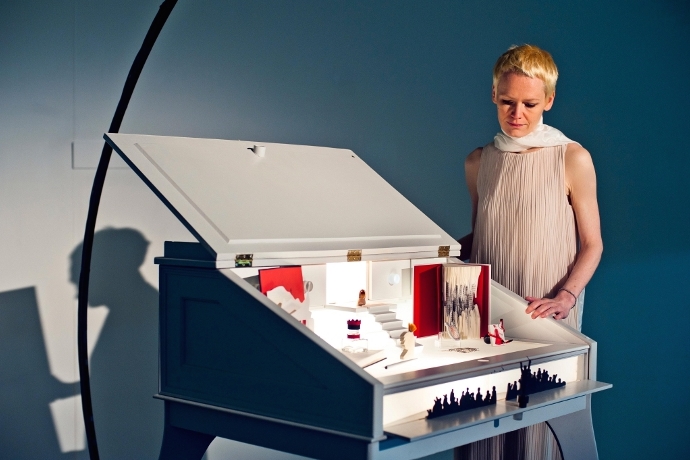
Claudia Molitor and her Opera-in-a-desk. Photo: Tommy Ga-Ken Wan
The composer and artist Claudia Molitor challenges the idea of music and how we engage with it. Her work uses sound to explore locations and physical objects. In Sonorama, she created an audio accompaniment for the train journey between St Pancras and Margate, downloadable to your smartphone; Remember Me was centred around the intimate connection her own grandmother had with her writing desk.
Yet, Molitor initially took a conventional route into the music profession – via a degree at Sussex University and, on graduating, commissions for classical ensembles and orchestras. In fact, it was only recently that she began to combine sound with visual art and the written word to create works that seem more at home in the gallery than the concert hall.

The composer and artist Claudia Molitor
‘When you start out as a composer … it’s easier to think “this is the way a composer ought to be”,’ she explains. ‘Later on it’s much easier to let go and say, ‘well I don’t care what you’re supposed to be’ – you just do what it is that you want to do.’ Indeed, some of Molitor’s work doesn’t make a sound: zuhanden is a set of images depicting notation ‘growing’ from her hands, which the composer sees as an extension of sonic art. ‘It is completely (concerned with) the perspective of a composer –the fascination of looking at notation all the time, and using your hands to make something that will eventually become sonic,’ she says.
Whilst zuhanden explores Molitor’s private relationship to her art, her current project, The Singing Bridge, finds the artist facing outwards, using music and words to encourage interaction with our physical environment. This 40-minute sonic journey accompanies a walk over London’s Waterloo Bridge, and comprises compositions by Molitor alongside poetry and folk and electronic music exploring the bridge’s sounds and stories.
Stories are what I get most excited about.
The soundtrack evokes the bridge’s aural character with recordings of its deep vibrations. But the real interest for Molitor lies in the life around the bridge, ‘and in particular, our lives around it, how we relate to infrastructure like bridges.’ So it’s fortunate that the bridge has such a rich and unique social history, nicknamed the ‘Ladies Bridge’ after it was rebuilt during the Second World War by a female workforce.
‘The thing is, we take all this stuff for granted,’ Molitor points out. ‘Particularly when you are on Waterloo Bridge at rush hour, and everybody’s running through in their little bubble, very few people stop and look at these amazing views and listen to the Thames.’ She does not deny the irony in redressing this by playing them music through another set of headphones, but nevertheless, ‘it does make people stop and look and listen in a different way.’

The soundtrack of Molitor’s latest installation evokes Waterloo Bridge’s aural character
Whilst her work explores both monumental pieces of public infrastructure and intimate personal possessions, Molitor identifies a common thread. ‘I think the things that I’m most excited about are stories. That’s always what starts something off.’ The personal narrative of her ‘desk-opera’ Remember Me is particularly arresting. This was written after inheriting her grandmother’s own desk, which Molitor describes as ‘the only physical space that she could have truly called her own.’ In response, Molitor created an imaginary world within a writing desk – and was the opera’s sole performer.
Does she see herself as a storyteller? ‘It’s dangerous to say “story”, because that means that there is one “story” that I’m telling and that people are listening to it.’ She thinks that The Singing Bridge is a perfect example of this, since it is impossible to control exactly where the audience will be as they experience her sound journey. ‘It is designed to be flexible enough for everybody to construct their own story.’
Molitor is evidently excited by this openness and unpredictability. ‘There is no particular thing that the audience needs to take away,’ she insists. ‘But, obviously, you hope that that the audience will come away feeling somehow changed or somehow reconnected with their environment in a meaningful way.’ ![]()
Today is your last chance to catch The Singing Bridge